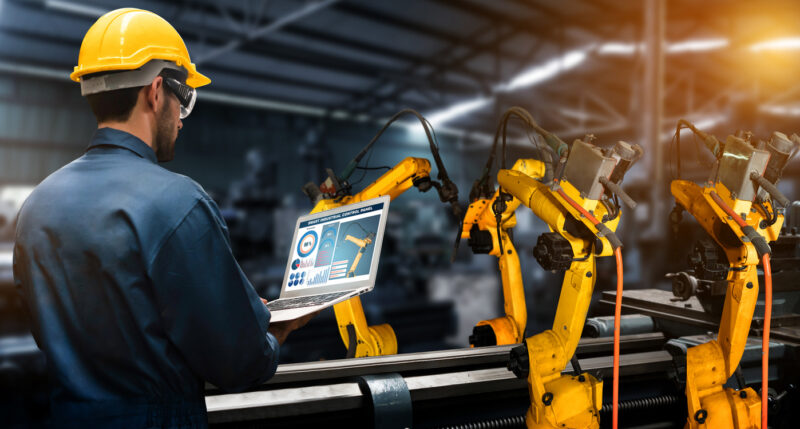Automation in logistics is shaping the future of the industry and powering innovation to meet modern challenges. The booming popularity of e-commerce puts logistics and shipping companies under intense strain. Automation technologies are helping them meet demand by boosting efficiency, streamlining operations, and improving workplace safety.
1. Autonomous Guided Vehicles
Autonomous guided vehicles, or AGVs, are one of today’s biggest trends in automation in logistics technology. These versatile robots power the ultrafast shipping customers have come to expect.
Often acting as couriers, these robots move throughout warehouses and fulfillment centers shuttling goods between departments and employees. They’re great for reducing the amount of physical strain on workers while also improving efficiency.
Amazon’s warehouses and sorting centers are a perfect example of AGVs in action. Amazon has been using warehouse robots for years and owns an in-house robotics developer, Kiva Robotics. In June 2022, Amazon launched its first fully autonomous AGV, Proteus. This robot has advanced safety and navigation sensors that allow it to move throughout warehouses independently.
Most AGVs require geofencing, tracks, or programmed routes to navigate logistics facilities safely. Various sensors, like cameras and distance sensors, detect the robot’s surroundings so it knows to stop when a barrier or person is nearby. New developments are making AGVs smarter and more capable every year.
2. Pick-and-Place Robots
Pick-and-place robots are robotic arms that package goods or move boxes. Today’s models go well beyond simply using mechanical claws. Engineers have developed innovative designs for these robots to help them do their jobs as efficiently as possible.
For example, Israeli robotics developer BionicHIVE has invented a unique pick-and-place robot called SqUID that uses suction to lift boxes weighing up to 35 pounds. Using suction cups to lift objects allows SqUID to interact with more items using a mechanically simple design. A claw mechanism would limit it to products within certain dimensions and require more moving parts.
Pick-and-place robots like SqUID are helping warehouses and logistics companies automate their inventory management operations. These bots also make logistics jobs safer. For instance, they can retrieve inventory on high shelves instead of an employee using a basket crane. More adept, dextrous gripper technology will help these robots take on additional tasks in the years ahead.
3. Automated Logistics Software
Physical automation in logistics isn’t the only technology innovating the industry. Software is also giving warehouses and logistics companies a boost. Applications range from data processing to inventory management, demand forecasting, and more.
For example, smart load board apps have become a popular tool for automating finding the best shipping partners. These apps use AI and machine learning to match carriers with freight optimized for miles and capacity. The boards track shipping rates and vehicle capabilities to save time and money.
Logistics companies are also using apps to automate demand forecasting and data processing. AI and machine learning algorithms have become more capable and accessible over recent years. As a result, more businesses are using them to analyze data and extract valuable insights autonomously.
For example, an AI algorithm could analyze performance data from various warehouse departments and pinpoint bottlenecks. Managers could then use this information to concentrate optimization and automation efforts on operations that need the most attention.
4. Automated Quality Control
Quality control may be more closely related to manufacturing but is also important for logistics and shipping. For instance, how do managers ensure boxes are packed and sealed properly in an automated warehouse? Quality control is a key part of fully automating operations.
Engineers have developed automated quality control systems using AI, computer vision, and cameras. These systems are effective and faster than human inspectors. Quality control can be repetitive and monotonous, so automation allows employers to redirect employees to more valuable roles.
Companies are already putting automated quality control systems into practice. For example, health care manufacturer Baxter International uses an AI system developed by Amazon Web Services to automate quality control for its delicate medical products. The AI uses image recognition to differentiate defective and properly assembled items. Faulty products are flagged for inspection by an employee.
The application of automated quality control for delicate products like health care items clearly indicates this technology’s capabilities. It isn’t just limited to manufacturing but could be used in any industry where quality monitoring is important. In logistics, AI quality control could monitor packaging techniques, packing material quality, box folding, and more.
5. Stacking and Palletizing Robots
Stacking and palletizing might be simple tasks, but they are monotonous for employees and cost thousands of dollars per year in wages. These jobs are also more likely to cause injuries, so automation can improve employee safety. Robots have emerged as a great solution to automating this corner of shipping operations.
Robots are the ideal tool for handling packages. They are designed to operate with high precision, and repeatability is baked into every task. A machine can do the same thing countless times without unpredictable variation or diminishing returns — except for rare malfunctions.
For example, robotics developer Boston Dynamics invented a stacking robot that can handle 800 boxes per hour or approximately one box every five seconds. Moving that fast for a prolonged period while lifting heavy boxes could lead to serious injury for an employee. Machines remove this risk without sacrificing efficient operations. The Boston Dynamics robot can completely automate moving packed boxes from a conveyor belt into a shipping container.
6. Automated Storage and Retrieval Systems
The rising popularity of e-commerce is creating a shortage of warehouse space, causing rental rates to increase and putting a premium on every square foot available. Logistics companies need to optimize how they use their facilities to make the most of their space. Automation is helping them accomplish this by innovating product storage.
Warehouses are traditionally designed with wide aisles for people and vehicles to move through. Wouldn’t it be convenient if this space could also be used for storage? Warehouse robots are making this possible by allowing shelving units themselves to be mobile. AGVs act as transportation for whole shelving units.
This is exactly what Amazon is doing with Proteus. The AGV is flat so it can drive under shelving units raised off the ground. The shelves can be organized tightly together since there is no need for aisles, maximizing efficient use of floor space.
An inventory management system tracks where products are located and tells the AGVs which shelves to retrieve. The robot navigates to the appropriate unit, clamps underneath the shelf, and drives it to where employees are waiting to collect items and pack orders. This strategy keeps workers out of high-risk areas in aisles.
Any logistics company can utilize this automation tactic to make the most of warehouse space. AGVs are widely available today and becoming smarter every year.
Innovating Automation in Logistics
Automation in logistics is helping the industry evolve to meet today’s challenges. Robotics, AI, and automated software are vital to the future of logistics and shipping. These technologies give companies a boost in efficiency, optimize operations, and improve workplace safety.









